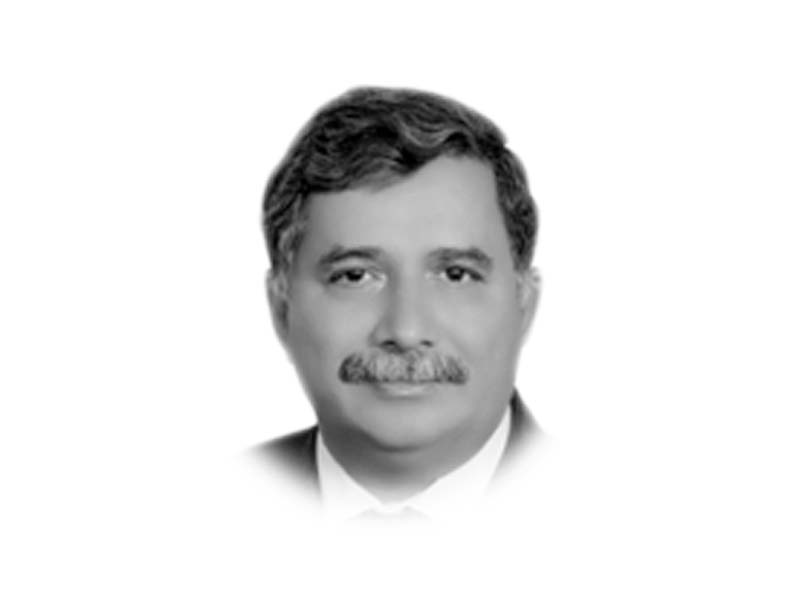
Due to the US elections the Afghan peace process had remained stalled amidst a wait-and-see policy by all parties within Afghanistan. After the Democrats’ victory in the elections, the peace process has jump-started once again. It will not be out of place to quote Hillary Clinton that leaders and nations understand the difference between war and peace, poverty and prosperity, and therefore have to make hard choices between at different junctures of history. Today, major global powers and leaders of Afghanistan stand at the crossroads of history to make a choice between peace and progress or a continued era of doom and destruction.
In this context, the Doha Agreement was signed with a noble objective of peace, but reports emanating from various sources such as the Special Inspector General for Afghanistan Reconstruction (SIGAR) indicated an ever-increasing number of deaths and injuries of the civilian population. On assuming the office of president, Joe Biden announced to review the Doha Agreement as he presumed that objectives of comprehensive peace had not been achieved.
Given this, Secretary of State Antony Blinken floated several proposals in a letter to President Ashraf Ghani, calling for bringing the two sides together for a UN-facilitated conference with foreign ministers and envoys from Russia, China, Pakistan, Iran, India and the US “to discuss a unified approach to supporting peace in Afghanistan”. This also simultaneously stresses for holding talks between the Afghan government and the Taliban in a senior-level meeting in Turkey in the coming weeks, aiming to work out a revised proposal for a 90-day reduction in violence. Blinken has also opined before the Congress that the US administration would minutely examine the negotiations, to understand the commitments made by the Taliban and observe to what extent the Taliban had progressed in talks with the Afghan government. He also indicated that the US would end the so-called war permanently and withdraw its forces, but would retain a capacity to prevent the re-organisation of terrorists.
In the same vein, US National Security Advisor Jake Sullivan underscored that the US would support the peace process with a robust and regional diplomatic effort. This would aim to help the two sides achieve a durable and just political settlement and permanent ceasefire. Sullivan also made clarified America’s intention to review the February 2020 US-Taliban agreement, including to assess whether the Taliban was living up to its commitments to cut ties with terrorist groups, to reduce violence in Afghanistan, and to engage in meaningful negotiations with the Afghan government and other stakeholders. In response the Taliban said that they respected the terms of the agreement and had the same expectation from the other side. However, in another statement they threatened that if foreign forces did not withdraw till spring, then the group would launch attacks against foreign forces.
The situation took a new turn with suggested plans of the Biden administration asking for an interim power-sharing government between the Taliban and Afghan leaders, and stepped-up involvement by Afghanistan’s neighbours — including Iran — in the peace process. But, the Afghan President, rejecting the plan, made a counter offer to hold elections within the next six months subject to a ceasefire which is to be unveiled in Turkey. The source of the Presidential Palace also stressed that any future government should be formed through democratic process, not a political deal.
The Afghan government and the Taliban agreed to try to accelerate peace talks, at a meeting in Moscow (the Troika meeting). The US, Russia, China and Pakistan called on Afghanistan’s warring sides to reach an immediate ceasefire.
It may also be mentioned that those countries stressed that they “do not support the restoration of the Islamic Emirate”. Any peace agreement must include protection for the rights of all Afghans, including women, men, children, victims of war, and minorities, and should respond to the strong desire of all Afghans for economic, social and political development including the rule of law.
The delegation also called on the Taliban to not to pursue a spring offensive. On the other hand, the Taliban’s deputy leader Mullah Abdul Ghani Baradar told the Moscow conference that Afghans "should be left to decide their own fate" and the world should bear in mind Islamic values, independence and Afghanistan’s national interests. In this back drop, the US has suggested the role of the UN for the resolution of the conflict and monitoring. In another twist, the US President, in his interview with ABC, said that he was reconsidering the agreement with the Taliban and it would be “tough” for the US to meet a May 1 deadline to withdraw troops from Afghanistan but that the complete drawdown won’t take much longer.
All these ups and downs and analyses suggest that US is not in a hurry to leave Afghanistan. The US is trying to take other stakeholders in the region into confidence by their inclusion in the peace talks. The Troika conference in Moscow was the precursor to be followed by other conferences. President Ghani reiterated his offer of fresh elections and even agreed to step down, if it was accepted at the Heart of Asia Conference.
Mentioning of the UN indicates its increasing role in the future of the peace process. This process may converge into a mediating role and eventually into monitoring of any future elections and a peace keeping role between warring groups, a common practice under international law.
In the background of new developments, it is imperative for the warring factions to agree on a give-and-take strategy. But this requires a conducive environment. It is therefore necessary that as per Pakhtun tradition, parties to the conflict announce a teega, or a ceasefire, and avoid using guns to take over the government. A hard choice for all the parties to the conflict is to sit together, draw a constitution in accordance with the democratic aspirations of the people and to take part in elections under the auspices of the UN.
Despite IMF loan, China remains country's lifeline
Washington-based lender rolls out dozen conditions that country will have to meet in 6 months

ISLAMABAD:
Pakistan will meet a dozen conditions in six months to stay in the $6 billion International Monetary Fund (IMF) programme but its economic endurance still hinges upon an $11 billion continued Chinese lifeline.
The international lender on Thursday released its staff level report of the $6 billion programme, confirming that the government was in process of increasing electricity prices by Rs5.65 per unit or 36% from now till October.
This increase will put an additional burden of Rs884 billion on the consumers by June 2023, according to the circular debt management plan, which the cabinet approved last month as part of the actions to meet the IMF conditions.
Additionally, the government will slap new taxes equal to 1.1% of GDP or around Rs600 billion in June as part of the IMF condition, according to the report.
These conditions are among 11 actions that the government will take by September this year.
They are in addition to the five prior actions that the government took to convince the IMF board to approve its case.
They included the introduction of the Rs140-billion mini-budget, an increase in electricity prices by Rs4.97 per unit from December 2020 to January 2021 on account of quarterly and annual tariffs, introduction of amendments to the SBP Act and the approval of the circular debt management plan by the cabinet.
The government is implementing these actions to remain in the $6 billion IMF programme but at the same time, the report shows that Pakistan’s external financing needs are still largely met by Chinese continued support.
The IMF programme was aimed at putting the country on sustainable path by removing all bottlenecks to growth. But the country couldn’t enhance its exports and remains deeply dependent on foreign loans to remain afloat. Another objective of IMF programme was market based exchange rate, which too couldn’t help exports.
Chinese lifeline
The country's gross external financing needs -- the funds that it needs to pay off foreign loans and finance its imports -- amount to $27 billion over the next 12 months, according to the IMF.
These financing needs will be met by support from China’s $10.8 billion, the UAE’s $2 billion, the World Bank’s $2.8 billion, the G20's $1.8 billion initiative, the Asian Development Bank's $1.1 billion, and the Islamic Development Bank’s $1 billion, Pakistan informed the IMF.
The finance ministry told the Washington-based lender that key bilateral creditors had maintained their exposure to Pakistan in line with programme financing commitments.
However, Saudi Arabia has already withdrawn the $3 billion it had committed.
“China has maintained its exposure by renewing and augmenting the CYN 30 billion, (about US$4.6 billion) three-year bilateral currency swap”, the report confirmed.
The Express Tribune had reported that China had increased the size of bilateral currency swap from $3 billion to $4.5 billion to help Pakistan pay off Saudi loans.
The IMF report further read that China had renewed the maturing commercial loans as part of the programme financing assurance commitment.
China rolled over $2.5 billion commercial loans in this fiscal year and also plans to extend $4.4 billion in the next fiscal year.
The IMF report stated that China had also provided an additional $1 billion deposit in July 2020, raising the State Administration of Foreign Exchange (SAFE) deposits to $4 billion.
China’s continued financial support is “absolutely very critical for Pakistan”, Ernesto Rigo, the IMF’s Washington-based mission chief, said on Thursday while responding to a question.
The report also acknowledged that the commitments that Pakistan had made to remain in the programme were ambitious.
Prime Minister Imran Khan and Finance Minister Hammad Azhar have indicated renegotiating the IMF programme.
PM Imran has already shown the door to former finance minister Dr Abdul Hafeez Shaikh for making these commitments and not fully disclosing them to the premier, particularly those related to the NEPRA Act and SBP Act amendments.
Rigo said the programme was “not written on stone” and the Memorandum of Economic and Financial Policies (MEFP) by Pakistan was a “live document”. The mission chief added that Pakistan and the IMF were in discussions to see the impact of the second and third waves of coronavirus on the economy.
To another question, Rigo said the IMF did not receive a formal request from Pakistan to renegotiate the programme objectives.
The lender cautioned, in its report, that political tensions over reforms could weaken policy implementation, and undermine the country's adjustment and recovery path as well as debt sustainability.
Power tariff
The IMF report read that Pakistan’s cabinet had approved a timetable for the outstanding power price adjustments, which include this fiscal year’s annual rebasing, estimated at Rs3.34 per unit in the base tariff, and quarterly tariff adjustments, estimated as Rs1.63 per unit to catch up with past deferrals.
The IMF report further revealed that as a first step, the government had notified an increase of Rs1.95 per unit in January 2021 and completed the Q2–Q3 of the last fiscal year quarterly tariff adjustments of Rs1.63 per unit in December 2020.
The lender said the adjusted tariff now recovered about 90% of the power cost, excluding subsidies.
As part of the commitment, the “second-step annual rebasing is due in June and the Q4 FY 2020 QTA in September”.
The increases on these accounts are equal to Rs4.33 per unit, as per the circular debt management plan.
The IMF report further revealed that “Q1 FY 2021 QTA falls in April 2021 and is expected to be timely implemented under the automaticity of the amended NEPRA Act”.
This will lead to additional increases of Rs1.32 per unit, as per the plan approved by the cabinet.
The report noted that NEPRA Act “amendments will ensure the automaticity of quarterly tariff adjustments (QTAs) and reintroduce the option to levy surcharges if necessary”.
“here are no easy solutions and hard choices need to be made” in the energy sector,” said Rigo while commenting on the need for a massive increase in electricity prices.
According to another IMF condition, the government will rationalise the existing electricity subsidies by June. The payment of Rs180 billion to 45 private companies by end-May 2021 is also a condition.
The government has also made a commitment to amend the OGRA Act by June this year to increase the gas prices biannually.
There is also a condition to establish an asset declaration system with a focus on high-level public officials by end-June 2021, publication of the second review cycle report under the UN Convention against Corruption and review of the institutional framework for Pakistan’s anticorruption institutions by international experts.
The IMF has also imposed a condition for the introduction of the track-and-trace system for tobacco products by June 2021.
The government will have to make public Covid-19 related contracts it had awarded and beneficial ownership information of bidding and awarded legal persons on a centralised website by end-April.
According to another condition, the publication of the auditor general’s ex-post audit of the procurement of urgently needed medical supplies related to Covid-19 is also required by end-April.
The publication of an external audit of the Utility Stores Corporation by end-April and establishment of a robust asset declaration system end-June are two other new conditions.
Pakistan to become 23rd biggest economy by 2040: US intelligence report
Most populous countries in Asia are positioned to be among world’s largest economies, says Global Trends report
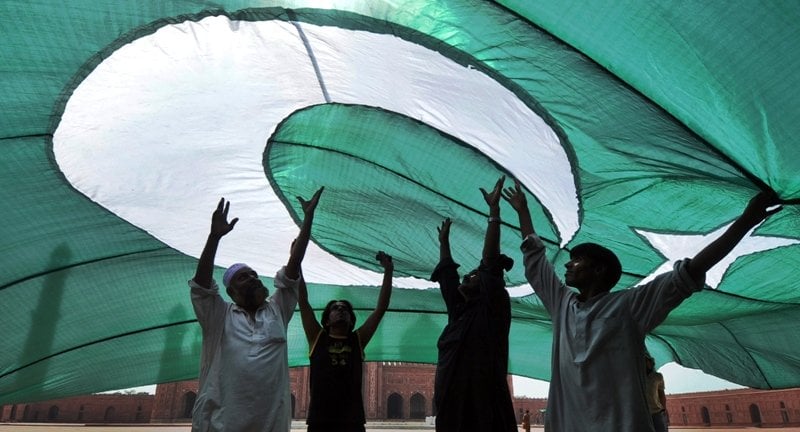
KARACHI:
Pakistan is set to become the world’s 23rd biggest economy by 2040 based on its predicted gross domestic product (GDP) rank which currently sits at 39th position, according to a United States intelligence report, which is issued every four years.
The assessment was included in this year’s Global Trends report by US National Intelligence Council (NIC), which is designed to help policymakers and citizens anticipate the economic, environmental, technological and demographic forces that are likely to shape the world through the next 20 years.
“Our intent is to help policymakers and citizens... prepare for an array of possible futures,” the authors wrote, noting they included input from diverse groups, from American students to African civil society activists.
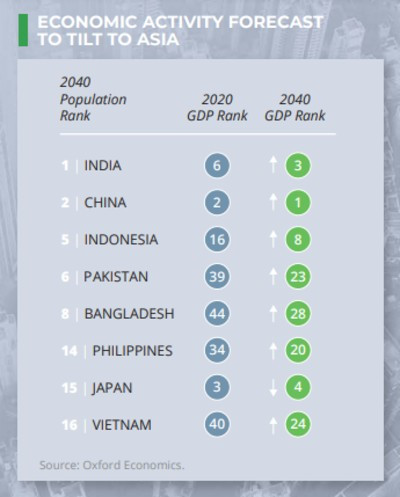
"Global economic activity has been tilting toward Asia during the past 40 years, reflecting its higher rate of economic growth in comparison with the rest of the world, large population, and reduction in grinding poverty — a trend that almost certainly will continue through at least 2030 and perhaps through 2040," the report said.
Read more: Pakistan can become $1.5-1.7tr economy
It said that some of the most populous countries in Asia are positioned to be among the world’s largest economies by 2040, even as their per capita incomes lag behind that of advanced economies.
"Asia’s record growth during the past 40 years has resulted in a convergence between Asian standards of living and those of middle and even high-income economies," the document stated.
In 2020, China and other developing Asia countries contributed 18 per cent and 7 per cent respectively to global GDP. "If these trends continue, by 2040 developing countries in Asia are projected to account for approximately 35 per cent of global GDP, with India and China as the largest contributors at 29 per cent of global GDP," the report quoted Oxford Economics.
It said that the faster economic growth in Asia could lead to some of the most populous countries being among the world’s largest economies by 2040. "For example, faster economic growth in India — on track to be the most populous country by 2027 — could propel the country into the ranks of the world’s three largest economies," the report stated.
Similarly, it said, faster growth in Indonesia — the world’s fourth most populous country — could allow it to break into the ranks of the top 10 economies by 2040.
Also read: Pakistan’s economy: somewhere it all went wrong
However, the reported added, their standards of living or per capita GDP are likely to remain well below those of advanced economies.
Pakistan likely to be below median age threshold in 2040
The report said that during the next two decades, most countries with large youth populations will be challenged to meet the basic needs of their populations, particularly in light of the social volatility often associated with youth bulges.
"In Sub-Saharan Africa, the median age is likely to rise only slightly to 22 by 2040, still well short of the median age threshold of 30 which is often associated with higher levels of human development."
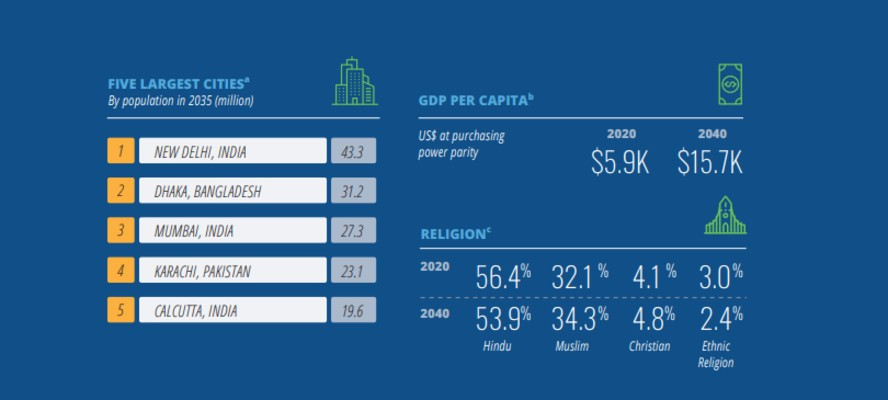
It said that more than one-third of Sub-Saharan Africa’s population will be younger than 15 in 2040, compared with only 14 per cent of the population in East Asia.
"Other populous countries that most likely will still be below the median age threshold in 2040 are Afghanistan, Egypt, and Pakistan," the report added.
Climate change, rich-poor gap, conflict likely to grow
The report said that disease, the rich-poor gap, climate change and conflicts within and among nations will pose greater challenges in coming decades, with the Covid-19 pandemic already worsening some of those problems.
It said that the rivalry between China and a US-led coalition of Western nations likely will intensify, fuelled by military power shifts, demographics, technology and “hardening divisions over governance models."
Regional powers and non-state actors may exert greater influence, with the likely result of “a more conflict-prone and volatile geopolitical environment” and weakened international cooperation, it said.
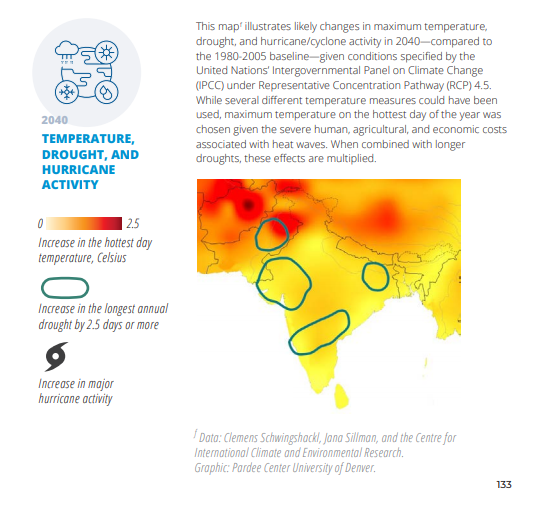
Challenges like climate change, disease, financial crises and technological disruption “are likely to manifest more frequently and intensely in almost every region and country”, producing “widespread strains on states and societies as well as shocks that could be catastrophic”, the report said.
It said the coronavirus pandemic that has killed more than three million people marked the greatest “global disruption” since World War Two, with the consequences likely to last for years.
Covid-19, it said, exposed – and sometimes widened – disparities in healthcare, raised national debts, accelerated nationalism and political polarisation, deepened inequality, fuelled distrust in government and highlighted failed international cooperation.
In the process, it is slowing – and possibly reversing – progress in fighting poverty, disease and gender inequality.
Many problems caused by the pandemic are forecast by the report to grow by 2040.
“There is a certain set of trends that we’ve identified that seem to be accelerating or made more powerful because of the pandemic,” said an NIC official, speaking on condition of anonymity.
The report posed five scenarios for what the world might look like in 2040.
The most optimistic – a “renaissance of democracies” – found that democratic governments would prove “better able to foster scientific research and technological innovation, catalysing an economic boom,” enabling them to cope with domestic stresses and to stand up to international rivals.
The most pessimistic scenario – “tragedy and mobilisation” – posited how Covid-19 and global warming could devastate global food supplies, leading to riots in Philadelphia that kill “thousands of people”.
'Covid-19 has shaken long-held assumptions'
The report said that Covid-19 has shaken long-held assumptions about resilience and adaptation and created new uncertainties about the economy, governance, geopolitics, and technology.
The document finds cause for concern in virtually all aspects of life. "Advances in technology have the potential to address problems including climate change and disease, but can also provoke new tensions," the report added.
The report also warned of eroding trust in government and institutions and of a “trust gap” between the general public and the better informed and educated parts of the population.



